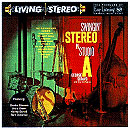Home · Listener's Guide · The Songs · Who's Who · Liner Notes · Selected Tracks · What's New · Search

George Siravo
- Born 2 October 1916, Staten Island, New York
- Died 28 February 2000, Medford, Oregon
George Siravo is best known as the orchestrator of Frank Sinatra's first two major albums, Swing and Dance with Frank Sinatra and Songs for Young Lovers, on which Sinatra for the first time really broke away from ballads and moved into the swinging style for which he will probably be most remembered.
By the time Siravo went to work with Sinatra, he was a veteran big band performer, having played alto sax in the reed sections of over a dozen bands. Growing up a few blocks away from another Sinatra arranger and space age pop great, Axel Stordahl, Siravo began learning the clarinet at an early age, and by the early 1930s, he had begun working professionally. Once of his earliest gigs was as a member of Harry Reser's Cliquot Club Eskimos, an ersatz Dixieland band that was one of the first groups to gain fame through radio. Percussionist Harry Breuer was another Cliquot Club alumnus.
Through the 1930s and into the early 1940s, Siravo wandered from band to band, playing with Jan Savitt, Charlie Barnet, Will Hudson, and Artie Shaw. He played in Glenn Miller's first band and joined Gene Krupa in 1938, when Krupa left Benny Goodman. He eventually quit the road in favor of working on the staff of the radio show, "Your Hit Parade." Siravo's first exposure to Sinatra was while the two were both working on the show, and Sinatra put him on retainer for his next radio show, "Frank Sinatra in Person."
He also began working as a free-lance arranger, writing for Krupa, Shaw, Barnet, and others. In late 1944, Axel Stordahl brought him in to help with what became one of Sinatra's trademark songs, "Saturday Night (Is the Loneliest Night of the Week)," and Will Friedwald has written in his excellent book, Sinatra! the Song Is You, that most of the credit for the tune's success should go to Siravo.
He joined the staff of Columbia Records in 1947, and when Sinatra and Columbia producer Mitch Miller decided to do an entire album of uptempo numbers, Siravo was their first choice. Sinatra later said of Siravo, "He's one of the untapped arrangers, I feel. He's a very fresh style guy, he's just fine." Unfortunately, both Sinatra and Miller got cold feet about a whole album of dance tunes, particularly since Sinatra's pipes were about to go due to an unrelenting schedule of radio shows, four club sets a night, and studio work, and a number of Siravo's arrangements went unrecorded.
Siravo attributed a lot of Sinatra's technique to the lessons he learned from jazz musicians. "Frank would hang out with the real hip instrumentalists, guys that could do anything you asked them to do. That's where Frank got it, from the trombones and trumpets and clarinets and saxophones." He also appreciated Sinatra's approach to studio work: "He was so flexible... He was the guy who could walk between raindrops without getting wet."
Siravo's career with Sinatra was sporadic, in part because the early 1950s were a time of such personal and professional turmoil for Sinatra. Siravo talked him out of doing a studio session in favor of grabbing a flight to Africa, where he joined Ava Gardner, who was filming "Mogambo," and started on his cycle of rotating wives. He did most of the arranging for Sinatra's first album after winning the Oscar for "From Here to Eternity," but Capitol Records ended up giving the credit to Nelson Riddle. For years, Siravo nursed a grudge about being cheated of the credit, but Riddle later passed on his apologies through Tony Bennett, and told Bennett that much of what he learned about writing for a singer without getting in his way he owed to Siravo. And when Riddle did the arrangements for Sinatra's tour of Australia in 1959, he brought in Siravo to handle the orchestration.
Siravo tried to keep Sinatra in perspective and "never let him mold me." He claimed that attitude led to Sinatra's dumping him around 1961. Sinatra called Siravo in New York and invited him to come join a golf tournament in Las Vegas. Siravo had a heavy schedule of studio work and told Sinatra, "You gotta be kidding, I'm busy." Sinatra replied, "I'll send my jet." Siravo told him, "You're out of your mind." "That was the last time I ever talked to him," Siravo later told a reporter.
Sinatra was not the only singer to credit Siravo for a hit. Songwriter Sammy Cahn said Siravo was the reason Doris Day's 1950 single, "It's Magic," became a hit, and he helped Tony Bennett with one of his most successful albums and singles, Who Can I Turn To?. He also worked with Vic Damone, Jimmy Rosselli, Connie Boswell, and Rosemary Clooney.
 Siravo recorded under his own name only intermittently. His best-known album, Swingin' in Studio A is a fine example of big band arranging and top-notch studio engineering and is the sort of thing audio engineering legend Henry Kloss probably had in mind when he said that the best demonstration of his pioneering headphones was "a great big band album written for stereo and recorded with top studio musicians and engineers." It may not be as splashy as an Esquivel album, but in its own way, it may be more representative of space age pop as a whole. He also recorded a showcase album for Time, Seductive Strings, that featured Doc Severinsen on trumpet. His personal favorite may have been an obscure album of small ensemble, chamber music-influenced jazz recorded for Kapp Records, Polite Jazz.
Siravo recorded under his own name only intermittently. His best-known album, Swingin' in Studio A is a fine example of big band arranging and top-notch studio engineering and is the sort of thing audio engineering legend Henry Kloss probably had in mind when he said that the best demonstration of his pioneering headphones was "a great big band album written for stereo and recorded with top studio musicians and engineers." It may not be as splashy as an Esquivel album, but in its own way, it may be more representative of space age pop as a whole. He also recorded a showcase album for Time, Seductive Strings, that featured Doc Severinsen on trumpet. His personal favorite may have been an obscure album of small ensemble, chamber music-influenced jazz recorded for Kapp Records, Polite Jazz.
Siravo and his wife retired to Oregon in 1983, picking out the town of Medford from a map. "It's close to California, how different can it be?" he later explained.
Recordings
- Out on a Limb, Ad Lib A226
- Dancing in the Dark, Harmony LP
- Portraits in Hi-Fi, Decca LP
- Everything Goes! The Music of Cole Porter, Epic LN-3803
- Swingin' Stereo in Studio A, RCA LSP-1970
- Seductive Strings, Bainbridge BT 1018 (also issued on Time Series 2000 S/2019)
- Polite Jazz, Kapp LP
S p a c e A g e P o p M u s i c
Home · Listener's Guide · The Songs · Who's Who · Liner Notes · Selected Tracks · What's New · Search
Email: editor@spaceagepop.com